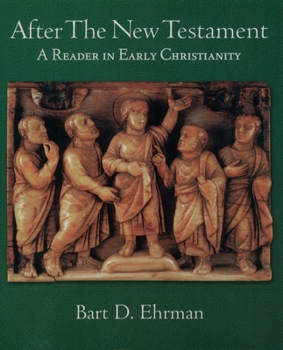After the New Testament: A Reader in Early Christianity
Select Format
Select Condition 
Book Overview
The remarkable diversity of Christianity during the formative years before the Council of Nicea has become a plain, even natural, "fact" for most ancient historians. Until now, however, there has been no sourcebook of primary texts that reveals the many varieties of Christian beliefs, practices, ethics, experiences, confrontations, and self-understandings. To help readers recognize and experience the rich diversity of the early Christian movement, After the New Testament provides a wide range of texts from the second and third centuries, both "orthodox" and "heterodox," including such works as the Apostolic Fathers, the writings of Nag Hammadi, early pseudepigrapha, martyrologies, anti-Jewish tractates, heresiologies, canon lists, church orders, liturgical texts, and theological treatises. Rather than providing only fragments of texts, this collection prints large excerpts--entire documents wherever possible--organized under social and historical rubrics.
This unique reader's concise and informative introductions and clear and up-to-date English translations make it ideal for courses on the New Testament, Christian Origins, Early Church History, or Late Antiquity. It will also be of interest to anyone--student, scholar, and general reader alike--interested in the entire range of early Christian literature from the period after the New Testament up to the writings of the so-called father of church history, Eusebius.
This unique reader's concise and informative introductions and clear and up-to-date English translations make it ideal for courses on the New Testament, Christian Origins, Early Church History, or Late Antiquity. It will also be of interest to anyone--student, scholar, and general reader alike--interested in the entire range of early Christian literature from the period after the New Testament up to the writings of the so-called father of church history, Eusebius.
Format:Paperback
Language:English
ISBN:0195114450
ISBN13:9780195114454
Release Date:October 1998
Publisher:Oxford University Press
Length:464 Pages
Weight:1.75 lbs.
Dimensions:0.9" x 7.5" x 9.3"
Customer Reviews
4 ratings
After the New Testament:A Reader in Early Christianity
Published by Thriftbooks.com User , 15 years ago
After skimming the book, it is my opinion that this book would be best used in a study or classroom setting. It is my intention to present this book to my Sunday School teacher and consider it for study. The class is more progressive and most will accept it as history(not like most classes I have attended). Bart Ehrman's books are very easy reading. I have learned a great deal from all the books I have ordered.
Historic Christianity
Published by Thriftbooks.com User , 16 years ago
Mr Ehrman leaves no stone unturned in tapping the vast and ever expanding reservoir of archaeological and hermeneutic studies of the early Christian movement. At the top of his class and certainly a blessing to read compared to some of the much dryer dissertations one comes across in the religious studies genre.
I bought this book because I like Harry Potter
Published by Thriftbooks.com User , 19 years ago
Book arrived in good condition and in a timely manner.
A Profitable Read
Published by Thriftbooks.com User , 20 years ago
I used this book in a course on Early Judaism and Early Christianity, which I took as an undergraduate. Although one may read a secondary reader, there is nothing like reading a well-chosen sampling of primary texts - and the selections here are just that: well-chosen. Although the Church traces its lineage and heritage through a particular history - the New Testament, followed by the Apostolic Fathers and they themselves followed by the Church Fathers - in reading this volume one immediately notices a spectrum of thought, filled with every subtle shade of variation that one could imagine. It is in reading the differences and polemical writings contained here that makes the battles between traditions so fascinating: after the New Testament, one can rightly speak of earliest Christianities. Somehow or another, though, they all find their raison d'etre in Jesus, the itinerant Jewis Hasid from Nazareth. Perhaps one may be generous enough to say that every writing in this book seeks to answer Christ's question to the Apostles: "Who do you say that I am?" From Gnostic writings and proto-orthodox Church Fathers to apocryphal Gospels and "lost" Epistles, one is thrust into a mass of movements, each of which claims to have the answer to this question. (And, as a side note, it turns out that the views of the Roman Catholic and Orthodox churches are, in fact, among the most ancient of these various other traditions.) Ehrman's introductions are short and to the point; they are helpful and note where writings develop earlier, more historical traditions, if writings were later declared orthodox or heretical and what the polemical context was of a particular piece. He also notes where texts were once used and where they were popular, and if and when they fell out of favor. Lastly, and most interestingly to this reader, is the short section that notes the development of the canon of the New Testament and how many books that are now taken for granted were hotly debated in those early centuries. One could easily spend hundreds of dollars collecting the various works that were important to and written by early Christians/s/s/s/s/...; this book is a wonderful, well-written selection of those works. As a supplement to studies in early Christianity, Judaism and/or later Antiquity, it will prove to be quite helpful and informative. For the interested lay person, this book will also prove to be both informative and an excellent introduction to the subject. In short, it is a profitable read.






